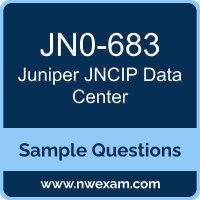01. Which two statements are correct?
(Choose two.)
a) Data center interconnect can only be a Layer 3 connection.
b) Data center interconnect can only be a Layer 2 connection.
c) Data center interconnect can be a Layer 2 or Layer 3 connection.
d) Data center interconnect is used to connect multiple data centers together.
02. What are two methods used to scale an IBGP IP Fabric?
(Choose two.)
a) confederations
b) redundant trunk groups
c) route reflection
d) spanning tree
03. To provision a Juniper QFX Series switch using Zero Touch Provisioning, which three components are required?
(Choose three.)
a) DHCP Server
b) a preconfigured device configuration file
c) a file server
d) multicast support
e) a DNS server
04. Which two statements are true with MC-LAG?
(Choose two.)
a) MC-LAG uses Inter-Chassis Control Protocol (ICCP) to communicate with a remote end point.
b) MC-LAG uses Link Aggregation Control Protocol (LACP) to communicate with a peer device.
c) MC-LAG uses Link Aggregation Control Protocol (LACP) to communicate with a remote end point.
d) MC-LAG uses Inter-Chassis Control Protocol (ICCP) to communicate with a peer device.
05. What is the endpoint of a VXLAN tunnel?
a) DLCI
b) VTEP
c) LSR
d) VCF
06. Which two statements are true regarding IP fabrics?
(Choose two.)
a) An IP fabric uses Spanning Tree Protocol to avoid loops.
b) An IP fabric uses routing protocols to avoid loops.
c) An IP fabric uses standby links for redundancy.
d) An IP fabric load balances across links for redundancy.
07. When QFX5100 series and EX4300 series are in a Virtual Chassis, which two statements are true?
(Choose two.)
a) The Virtual Chassis stack scales down to the lowest maximum scaling number between members.
b) The Virtual Chassis stack scales up to the highest maximum scaling number between members.
c) The scale capacity of each switch is dependent on the model of the switch.
d) QFX5100 and EX4300 switches do not form a virtual chassis with each other by default.
08. Which two statements are true regarding EVPN Route Distinguishers?
(Choose two.)
a) It can contain a two byte administration field and a four byte assigned number field.
b) It can contain a four byte administration field and a two byte assigned number field.
c) It can contain a six byte administration field and a two byte assigned number field.
d) It can contain a two byte administration field and a six byte assigned number field.
09. What are two primary uses for VXLAN?
(Choose two.)
a) Create a Layer 2 overlay on a Layer 3 network.
b) Create a Layer 3 overlay on a Layer 2 network.
c) Provide data privacy and security in a datacenter.
d) Enable Layer 2 connectivity between remote hosts.
10. Which statement describes a Juniper Virtual Chassis Fabric?
a) two or more QFX Series or EX Series switches in a ring topology
b) two or more QFX Series or EX Series switches in a full mesh topology
c) two or more QFX Series or EX Series linked in a spine-leaf topology
d) two or more QFX Series or EX Series switches in a daisy-chain topology
 Before you write the Juniper JNCIP Data Center (JN0-683) certification exam, you may have certain doubts in your mind regarding the pattern of the test, the types of questions asked in it, the difficulty level of the questions and time required to complete the questions. These Juniper Networks Certified Professional Data Center (JNCIP-DC) sample questions and demo exam help you in removing these doubts and prepare you to take the test.
Before you write the Juniper JNCIP Data Center (JN0-683) certification exam, you may have certain doubts in your mind regarding the pattern of the test, the types of questions asked in it, the difficulty level of the questions and time required to complete the questions. These Juniper Networks Certified Professional Data Center (JNCIP-DC) sample questions and demo exam help you in removing these doubts and prepare you to take the test.